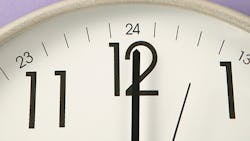Keeping Time Is Part of Measuring It
Time is an important parameter, in engineering, in business, and especially in life. In life, it is a reference by which we gauge the importance of different events. In engineering, it is especially critical to be quite precise and accurate about time because the performance of many other components and systems will depend upon it. The time-keeping capabilities of the satellite Global Positioning System (GPS), for example, have become the reference standard for many users, even those involved with RF and microwave measurements. Many newer test instruments provide an input port for connection of a GPS signal, to serve as an external time/frequency standard. But what are the other options when it comes to keeping time?
An earlier blog addressed measuring time and frequency, notably with frequency counters and different types of multiple-function analyzers. But keeping time is a different matter, and it is essential to keep precise time in order to measure it accurately. For that, test instruments must be synchronized to a reliable time-keeping standard, such as the signals from a GPS satellite. But any number of different frequency/time sources, including various types of oscillators, can be used as time-keeping standards for high-frequency instruments, with differing levels of performance. RF/microwave instruments are commonly timed by means of 10-MHz crystal oscillators, with the stability of such oscillators improved by inclusion with temperature-compensation circuitry as temperature-compensated crystal oscillators (TCXOs) or with oven-controlled environmental stability, in the form of oven-controlled crystal oscillators (OCXOs).
These are excellent frequency/time references, but even greater precision and accuracy is available with slightly more investment, in an atomic clock. Such time-keeping standards as cesium- or rubidium-based atomic clocks are the time references by which many measurement facilities and calibration laboratories are run. Yes, they can be expensive, especially when compared to a TCXO- or OCXO-based module that plugs into a frequency counter, but they can also provide the ultimate performance in terms of precision time and frequency measurements. When tied to an instrument like a vector network analyzer (VNA), oscilloscope, or spectrum analyzer, the benefits can be appreciable in terms of improved jitter measurement capability in the time domain and enhanced phase-noise measurement capability in the frequency domain.
One of the organizations very concerned with accurate timekeeping for precision measurements, the U.S. National Institute of Standards and Technology (NIST), has spent a great deal of time (forgive the pun) in evaluating the differences among precision oscillators and frequency references, such as cesium and rubidium standards, and how they impact measurement precision. NIST offers an excellent short paper, “Selecting a Primary Frequency Standard for a Calibration Laboratory,” available for free download here. Written by NIST’s Michael Lombardi, the white paper compares the performance for different time-keeping sources, such as OCXOs, rubidium atomic clocks, and cesium atomic clocks, and even includes a comparison to a GPS-based reference. It provides tabular guidelines for comparing different time-keeping standards, using such parameters as typical frequency accuracy, stability for one second, and aging rate over one year. It also shows the typical phase-noise range offset 10 Hz (close in) from the carrier. The parameters listed in the table are excellent figures of merit for anyone in search of a frequency/time reference standard.
NIST has explored various atomic clocks from different suppliers and how their time-keeping capabilities affect RF/microwave measurements. The investment in an atomic clock is not insignificant. But for applications where that extra amount of jitter or phase-noise measurement capability might be needed, the cost might be worth it.
About the Author
Jack Browne Blog
Jack Browne, Technical Contributor, has worked in technical publishing for over 30 years. He managed the content and production of three technical journals while at the American Institute of Physics, including Medical Physics and the Journal of Vacuum Science & Technology. He has been a Publisher and Editor for Penton Media, started the firm’s Wireless Symposium & Exhibition trade show in 1993, and currently serves as Technical Contributor for that company's Microwaves & RF magazine. Browne, who holds a BS in Mathematics from City College of New York and BA degrees in English and Philosophy from Fordham University, is a member of the IEEE.

